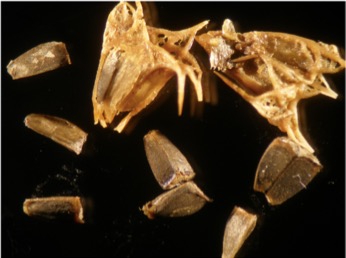600-Year-Old Swedish Guts Reveal Secret Medieval Remedies for Suffering
by Sarah-Kate Unkefer

Credit: Heimdahl & Vretemark, 2018
Analysis of stomach contents and fecal matter in Nya Lödöse, a medieval town located in the southern part of Sweden, unearths secretive medical practices used by midwives and women in the Middle Ages.
KEYWORDS: medieval, herbalism, archaeobotany, bioarchaeology, women, anthropology
In the bustling, international-trade town of Nya Lödöse, Sweden between 1473 and 1624 A.D., midwives and the common folk most likely kept their herbal remedies for menstruation, menopause, and birthing complications under wraps. Several individuals from this site had medicinal herbs in their stomachs, including one woman who drank motherwort tea to ease her pain during childbirth and stimulate contractions shortly before she and her newborn were buried together. Yet, historical documentation fails to illustrate how important herbalism was to the town.
During this time period, religious leaders were suspicious of the medicinal practices used by midwives due to the possibilities of abortion or poisoning. “It seems that this did not affect the practices among women, but I believe it stimulated a culture of secrecy,” said Jens Heimdahl, lead author of the paper. Because of this, many of the herbs used for and by women were kept from the church – the literate part of society – and thus were excluded from the historical records of the town. Hardly any information regarding herbalism is in the written record before the 17th century, so little is known about the medicinal practices of the illiterate majority.
Swedish religious leaders documented the practices used by barber-surgeons, medical practitioners who traveled between towns and often performed techniques such as surgery and blood-letting. After excavating Nya Lödöse, Jens Heimdahl and Maria Vretemark unexpectedly found medicinal herbs and spices in the stomachs of individuals that had been buried for 600 years. Despite this site being hundreds of years old, the bog-like soil preserved some of these individuals’ last meals. The parts of the plant used and where the plant was found illustrated whether the herbs were used medicinally or for food.
Many final gulps consisted of petals and seeds from plants such as mayweed, yarrow, and marigold that would have been in tea to soothe an aching stomach. The soil also preserved latrine waste that contained the seeds of Corydalis spp., a genus of medicinal plants used to aid in the healing process after birth. Some excavated gardens included motherwort and marigold, historically used during childbirth and menstruation. These provide further evidence for herbalism and medicinal practices focused on women in this town.
This archaeological evidence put a new twist on the historical records. Nya Lödöse “illustrates the differences between written history and archaeology – and how new layers might be discovered in the combination of the two,” Heimdahl said. The skeletal remains illuminated quite a broad knowledge of Swedish herbal medicine and caretaking that was otherwise absent from early written records.
References
Heimdahl, J., & Vretemark, M. (2018). Oozing ulcer: Herbal cure the medical cultures of Nya Lödöse reflected in bones and plants. International Journal of Historical Archaeology, 22(2), 314–342.
Acknowledgements
I would like to thank Dr. Jens Heimdahl, Dr. Laurie Reitsema, James Hataway, Katie Reinberger, Dr. Lindsey Harding, Rebecca Klee (the editor), the reviewers, and Emory Perry for inspiring the final product of my article. The synthesis of all your knowledge and advice created something I am proud of.